Supporting details is part of the Sustrans traffic-free routes and greenways design guide. It provides an overview of engineering applications such as lighting, fencing and landscaping to consider when designing a traffic-free route.
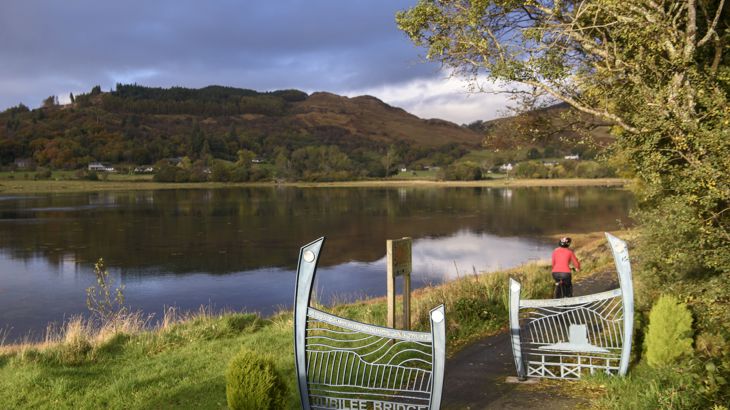
Key principles
- Engineering applications such as lighting, fencing and landscaping are important considerations when designing a traffic-free route.
10.1 Lighting
10.1.1
The benefits of lighting a traffic-free route include:
- Improving user ability to navigate the route, particularly at junctions with other routes and decision points.
- Enabling users to identify other users on the route.
- Detection of hazards ahead.
- Discouraging anti-social behaviour and crime.
- Increasing a sense of personal security.
The drawbacks of lighting a traffic-free route include:
- Light pollution.
- Visually intrusive lighting infrastructure.
- Overspill of lighting to nearby residential dwellings
- Vandalism of lighting infrastructure and increases in anti-social behaviour.
- Ongoing cost for power supply and maintenance of infrastructure.
10.1.2
Designers should consider the provision of lighting on traffic-free routes where significant use can be expected after dark.
This is important on those routes that are used by commuters, and those forming part of a safer route to school network, where usage is normally sustained throughout the winter months.
10.1.3
Many routes used primarily for recreational purposes, typically situated outside of built-up areas, are usually unlit.
However, the location, environment and user composition of each recreational route will all be unique and the provision of lighting should be considered on a case-by-case basis, paying close attention to risk, ecological impacts and cost-benefit.
10.1.4
Lighting may need to be provided wherever traffic-free routes have an interface with the highway network, or where road safety concerns exist.
Where lighting is considered necessary at highway interfaces, or alongside the highway, street lighting proposals will need to be discussed with the Local Highway Authority.
This will be important where the adjoining Highway is not sufficiently lit, or does not meet current standards.
Where lighting is provided at highway interfaces, Local Authorities would normally expect the lighting provision situated within the public highway to achieve the requirements of BS 5489-1:2020 - Design of road lighting Lighting of roads and public amenity areas - Code of practice.
10.1.5
Signing on traffic-free routes may need to be lit, or be reflectorised, where significant use is expected during the hours of darkness.
This is important for signs that are advising users of hazards or restrictions along the route, such as limited headroom at an overbridge.
10.1.6
The advancement of street lighting technology has resulted in a number of systems and products being developed that can overcome some of the issues discussed in Section 10.1.1. These include:
- Solar-powered lighting columns that do not require an electricity supply.
- Low-level lighting that isn’t as intrusive to neighbouring residential dwellings.
- Sensor-activated lighting that is only active when a user is on the route.
- Surface-mounted lighting that is difficult to destroy or vandalise.
- Lighting provided within timber posts, that is more in keeping with natural environments.
Whilst some of this technology may not provide sufficient levels of lighting for highway environments, or traffic-free routes that are used regularly during the hours of darkness (utility routes), they may be adequate for some recreational routes where a risk assessment has concluded that lighting intervention is required.
10.1.7
Whilst lighting can be used to discourage anti-social behaviour, this should not be used as a location-specific intervention along a route, as sudden changes in light levels could serve to create shadows that can encourage anti-social behaviour further.
Furthermore, sudden changes in lighting levels can also cause discomfort to route users.
10.1.8
Designers should consider that lighting can have an adverse impact on wildlife, including:
- Acting as a lure to migrating birds, which may become disoriented.
- Attracting high levels of insects, resulting in predators taking advantage of gathered prey.
- Drives away some nocturnal pollinators, reducing the ability of plants to bear fruit.
- Increases the proportion of microorganisms in freshwater sediments that are able to photosynthesize under low light levels.
- Disruption of circadian rhythms, altering the timing of sleeping, foraging, mating, and migration.
Designers should seek the advice of an ecologist during the planning and design stage of a route.
Ecological impacts should be determined at an early stage so that designers can develop the most suitable design solutions to eliminate or mitigate ecological impacts created by lighting.
Mitigation of ecological impacts created by lighting could include:
- Protecting existing dark spaces.
- Creating new dark spaces.
- Altering the spectrum of artificial lighting.
- Reducing artificial light trespass.
- Dimming of artificial lighting.
- Part-night lighting.
Designers should work with ecologists to understand the level of mitigation required and then explore the technology available to assist them in successfully achieving this.
These solutions may include further exploration of the technology summarised in Section 10.1.6.
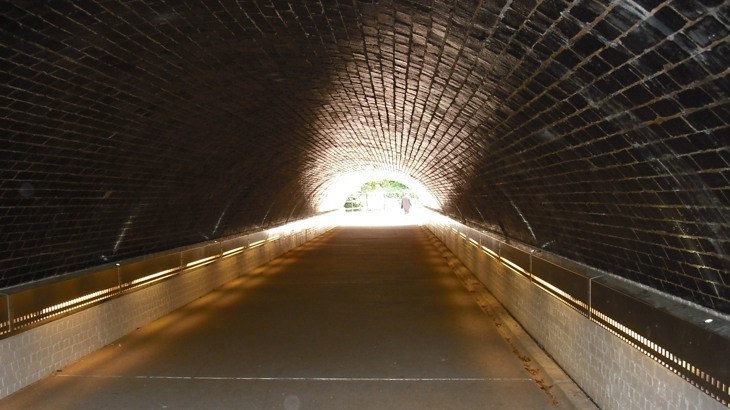
Low-Level Lighting in tunnel, Dartford.
10.1.9
Where it is not possible to light a busy traffic-free route due to visual intrusion or ecological impacts, users should be diverted to a parallel lit route.
However, designers should not simply divert users to the most direct or shortest alternative route.
Routing users along quieter, low-volume and low-speed roads would be the preference under these circumstances.
10.1.10
When designing lighting, consideration should be given towards the effect that lighting columns could have on the effective width of the path.
To achieve sufficient effective widths, lighting columns should be set back from the path edge. However, offsetting columns relative to the edge of the path should be considered in terms of power supply easement, the provision of shallow ducting and maintenance access requirements.
On structures or sections of the path where width constraints are encountered, alternatives to locating lighting columns within the path should be sought.
These alternatives may include mounting lighting units on other features, such as walls or parapets, or using strip lighting alongside the path.
10.1.11
Network-wide plans should be considered at the time of designing lighting along a route.
Where a route could be widened in the future, then the positioning of lighting infrastructure should account for this to mitigate the need for future costly changes.
Similarly, the future introduction of interfaces with intersecting routes should also be considered and passively incorporated into the lighting design where possible.
10.1.12
Solar-powered studs are unlikely to provide sufficient levels of illumination to offer any benefit beyond delineating the edge of a route.
Where provided, solar studs should be inspected regularly and kept clear of fallen leaves, standing water, encroaching vegetation and general debris.
10.1.13
In areas where it is not feasible to introduce an electrical supply, solar-powered column-mounted lighting may be an option. These systems typically involve discrete units with a photovoltaic panel on the same column as the lighting unit.
10.1.14
Maintenance of lighting systems should be considered during the planning and design of a traffic-free route.
Lighting columns can be designed to be lowered to avoid the need for access to be provided for a larger vehicle with an elevating platform to maintain the lighting units.
The maintenance of electrical equipment requires a different skillset to more general traffic-free path maintenance and this would need to be considered during the design of a system.
It is also necessary to consider the ongoing maintenance and electrical supply costs for a lighting system over the lifetime of the route.
10.1.15
Further guidance on the design of lighting for cycling infrastructure can be found in the Professional Lighting Guide 23, Lighting for Cycle Infrastructure (Institution of Lighting Professionals, 2020).
10.2 Road crossings
10.2.1
Traffic-free routes are likely to have an interface with the public highway network, either at the ends of a route or where the route crosses a road.
Where a route crosses a road mid-link, in other words, not at a junction, the type of crossing to be provided should be as set out in the table below.
10.2.2
Grade-separated crossings will involve either a bridge carrying the traffic-free route over the road or a subway/underpass carrying the route beneath the road.
The design of such structures is discussed in Section 10.4. For the design of signal-controlled and priority crossings, reference should be made to the relevant highway and Urban Traffic Control design guidance.
10.2.3
Where crossings of the public highway are required, the design of these features should be discussed with the Local Highway Authority at the earliest possible opportunity.
This is important where the introduction of traffic signal control may have a wider impact on traffic operation within the surrounding highway network.
10.2.4
Where crossings of the public highway network are required, warning signs advising traffic of a cycle crossing may be warranted. Where required, these signs should be introduced in accordance with the TSRGD.
If the crossing is introduced at a location that has a known road safety issue, or is highlighted as a possible road safety concern through the Road Safety Audit process, then further warning intervention may be required.
These can include features such as cycle-actuated signing that will display a warning message to vehicle traffic once activated by approaching people on bikes.
These types of features are far more costly than traditional signing and would be subject to ongoing maintenance and electrical supply costs.
10.2.5
The alignment of a traffic-free route on the approach to a crossing should be designed to ensure that approaching users slow down naturally, as opposed to having to slow down abruptly for a poorly positioned access control measure.
Designers must aim to reduce the speed of users through a varied path alignment that provides adequate forward visibility to the crossing.
This will enable users to slow down at a rate that is comfortable to them.
Where designers cannot introduce an approach to a crossing that results in the self-management of user speed and behaviour, it may be appropriate to provide warning signs or markings on the traffic-free route to inform users that they are approaching a road crossing.
10.3 Bridges
10.3.1
Many traffic-free routes pass through environments that include a number of physical obstacles including railways, rivers, canals, small watercourses and roads. Bridges can be used to overcome these obstacles and provide high-quality continuous routes for all users.
Similarly, routes are often introduced alongside existing rail corridors, rivers and canals, all of which may have existing bridges passing over them.
Therefore, designers should assess how existing bridges along a proposed traffic-free route will affect the design, or how the introduction of bridges could improve the continuity of a route and level of service.
10.3.2
Bridges are termed ‘overbridge’ or ‘underbridge’. In the context of this guidance, an overbridge provides a means of access over the traffic-free route and an underbridge provides access under the traffic-free route.
The access provided over or under the traffic-free route could form a means of access for vehicle traffic, non-motorised traffic or livestock.
The table below sets out key considerations for each type of bridge.
10.3.3
It may be useful to adapt existing or disused structures for use as part of a traffic-free route. This may range from simply reopening a closed structure to installing a new bridge deck on existing abutments.
When adapting existing structures, it may not be possible to achieve the geometric design requirements that would be required of a new structure.
However, this need not necessarily preclude the use of the structure, particularly where any risks to users can be mitigated or where there are no other feasible design solutions.
When adapting existing structures, particular attention should be given to potential ecological constraints, as many structures are habitats to a range of protected species, including bats and nesting birds.
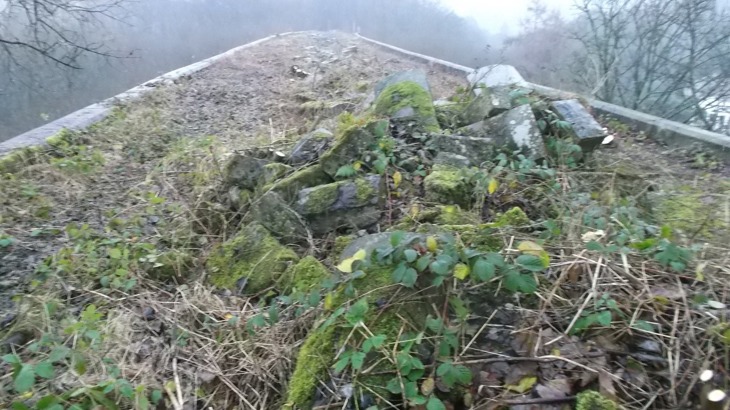
Pre-decking condition at Lumb Viaduct, Rossendale, Lancashire.
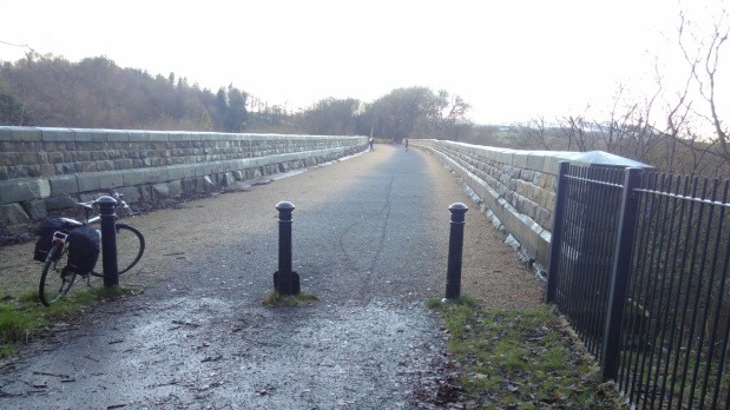
Lumb Viaduct as a traffic-free route, Rossendale, Lancashire.
10.3.4
The width of a route and type of provision over or under a bridge should be consistent with the adjacent route.
It may be necessary to provide additional width to compensate for any loss of effective width created by parapets (underbridges) or abutments (overbridges).
The significant expense of providing a new bridge means that it is important to ensure that the bridge is designed to accommodate anticipated growth in usage, as the costs associated with future widening of structures are not likely to be viable.
10.3.5
Headroom should be provided as set out in Section 6.2.1. For underbridges, the headroom requirements should be agreed with the relevant Technical Approval Authority
Parapets on a traffic-free route should be 1.4m high, or 1.8m high where equestrian use is expected/provided for.
Where existing structures are adapted, it may not be feasible to provide 1.4m high parapets for technical, planning/conservation or cost reasons.
In these cases, a lower than ideal parapet should be subject to a Designers Risk Assessment.
Depending on the outcomes from any risk assessment, measures implemented to mitigate the hazard associated with lower parapets could include:
- Locating the path away from the parapets, or directing people riding bikes or horses to keep away from the parapets.
- Re-profiling the bridge deck to increase the parapet heights.
- Providing dismounting blocks for people riding horses to dismount.
Many existing structures with lower than standard parapets have been successfully incorporated into routes.
Refer to Sustrans Technical Information Note 30 Parapet Heights on Cycle Routes.
10.3.7
Where new bridges are to be incorporated into a traffic-free route, the design must be undertaken by a suitably qualified engineer and approved by the appropriate Technical Authority.
10.3.8
Bridges may be constructed from a range of materials including concrete, masonry/brickwork, steel, timber or plastic composites.
Material technology is continually developing, making newer, lighter materials technically and financially viable.
The choice of material and form of a bridge can have a significant bearing on aesthetic qualities and whether the bridge becomes a feature on a traffic-free route.
10.4 Subways and Underpasses
10.4.1
Subways and underpasses can provide an alternative means of grade-separation to a bridge.
New subways are unlikely to be feasible due to the cost of excavating beneath an obstacle, compared to building a bridge over the obstacle.
Considerations in the design or adaption of subways and underpasses include the geometry of the access ramps to avoid blind corners, provision of adequate headroom, ensuring the personal safety of users by providing good visibility through a subway, the need for drainage to prevent flooding and the need for lighting.
In a number of European cities, subways are kept at ground level with the road being raised above the walking and cycling route. This approach is often more economical than raising people on bikes over an obstacle on an overbridge.
More specifically, motorised traffic requires more headroom than people on bikes and walkers.
Incorporating subways and underpasses into the traffic-free route can result in smaller structures being required when compared to routing motorised traffic through a subway or underpass.
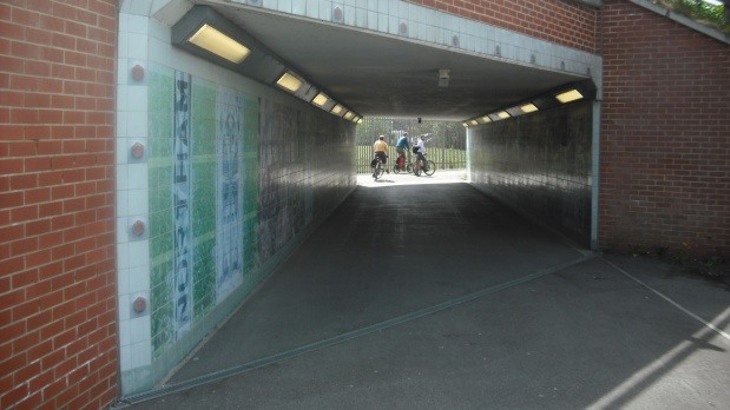
Subway underneath highway, Southampton.
10.4.2
Benefits of subways/underpasses include:
- Conflict free crossings.
- Avoids exposure to weather.
- More comfortable gradients than bridges and ramps.
10.4.3
Key design features include:
- Subways/underpasses require considerable investment.
- Where there are high user flows, separation should be considered.
- The crossing and its approaches should be straight or nearly straight.
- Where separation is required, a shallow 45o kerb face is normally sufficient.
Key minimum dimensions are outlined in the figures below:
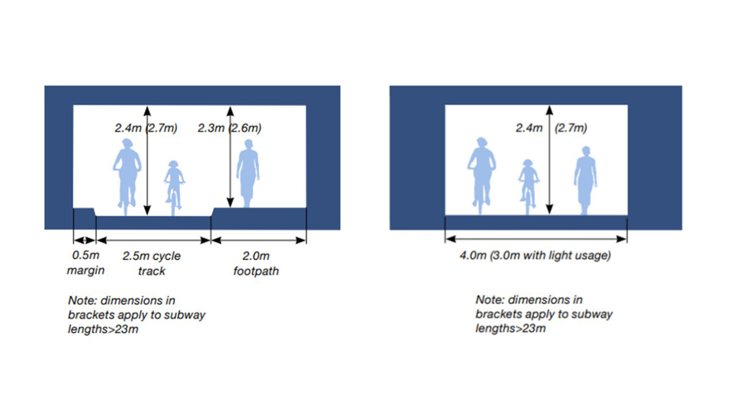
10.4.4
Generous headroom and width will be beneficial in terms of safety, natural surveillance and personal security.
However, where existing structures are being used, headroom may be limited.
In these instances, the restricted headroom should be subject to a Designers Risk Assessment to determine whether the risk to users can be safely mitigated.
One approach to mitigating this risk could be to clearly sign the restricted headroom. However, the Cyclist Dismount sign is not an accepted form of mitigation and should not be used.
10.4.5
Where lighting systems are proposed, these should be vandal proof to ensure that they function when needed by path users, but also to minimise future costs associated with replacement systems.
The design should also consider approaches to minimising the level of artificial lighting intervention.
This can include widening or diverging walls towards the top of the structure or using light wells, both of which will increase the level of natural lighting within the structure.
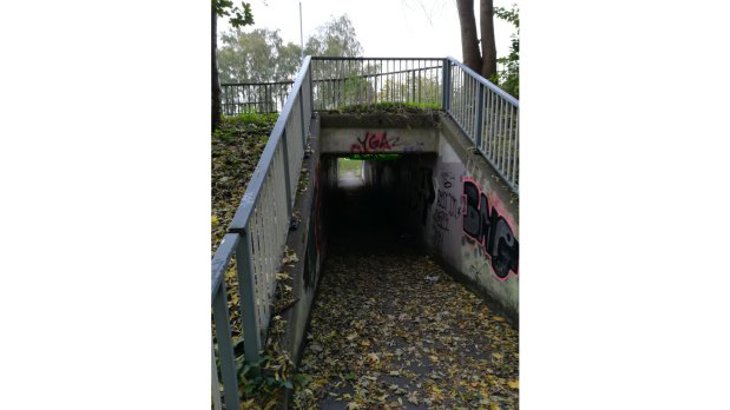
Uninviting and dark subway, Sharston, Manchester.
10.4.6
Bridges, subways and underpasses can all form habitats for a range of species.
As an example, an unlit subway/underpass may be a roost site or commuting route for wildlife, such as bats, that would otherwise be disturbed should the feature be illuminated throughout the hours of darkness.
As with any design proposal, the introduction of new, or modification of existing, subways and underpasses will require ecological impacts to be assessed at the planning and design stage.
10.4.7
The maintenance requirements of structures can be extensive. And a considerable level of resource is often required to address the outcomes of anti-social behaviour, such as graffiti, broken glass, damaged lights and litter.
These outcomes can be perceived as negative by users of a route, resulting in use being restricted to certain times of day, or alternative routes being sought.
The design of new structures, or modification of existing structures, should consider these outcomes by using an innovative approach towards design.
This could include using lighting systems that are incorporated into the structure and therefore are more difficult to damage, or using graffiti resistant coatings on the structure itself that can be easily cleaned or removed if defaced.
Furthermore, the structure can be designed to ensure that cyclic maintenance is made easier. For example, providing sufficient widths to enable a street sweeper to access the structure.
When designing new or improved structures, it is also important to involve the local community in the process, such as producing artwork for the structure.
10.5 Other structures
10.5.1
There are a number of other types of structure that may form part of a traffic-free route including retaining structures, boardwalks and tunnels.
10.5.2
Retaining structures are often needed to support a new traffic-free route, particularly where embankments are levelled to accommodate a path.
The use of retaining structures can often reduce the amount of land take required, for example, a ramp can be shortened and its gradient increased (within the limits discussed in Section 7.5.1) to reduce its overall footprint, as opposed to having a longer length of ramp that follows the natural contours of the land.
There are a number of options for creating retaining structures, all of which have different characteristics and are suitable for different situations.
As with all structures, a suitably qualified and competent person should design a retaining structure. Types of retaining structure include:
- Timber sleeper and pile walls
- Crib walling.
- Gabion baskets.
- Reinforced earth.
- Brickwork or blockwork.
- Sheet piling.
- Reinforced concrete.
- Paving slabs (suitable for low retained heights).
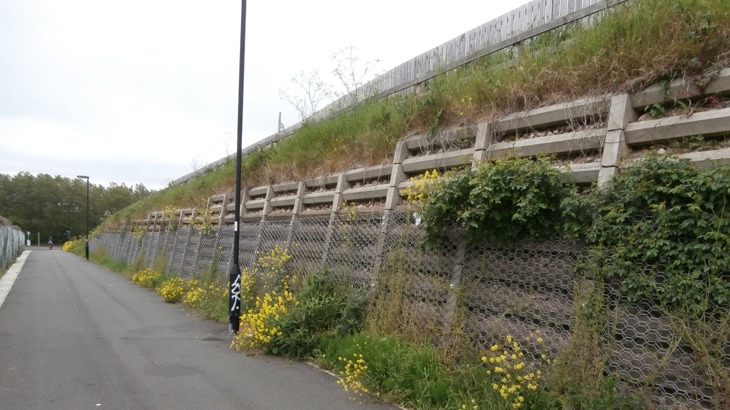
Concrete crib retaining wall alongside traffic-free route.
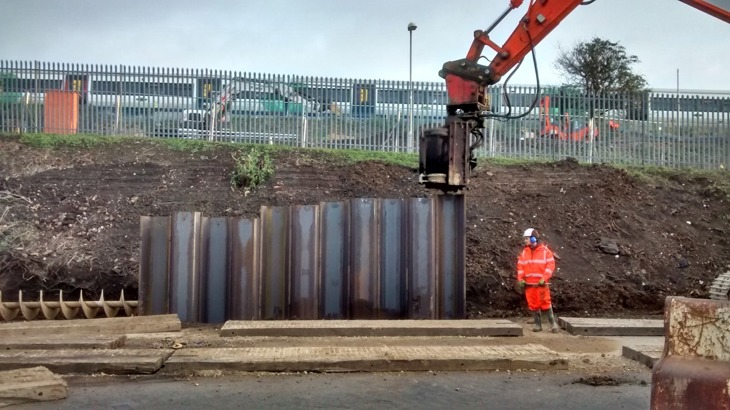
Sheet piling used to retain embankment, Millwall Path, London.
10.5.3
Boardwalks and similar elevated structures are often viable solutions within, or through, areas of ecological and environmental sensitivity or within flood plains. Boardwalks can sometimes require parapets to protect users from elevated edges, particularly on busy routes.
Boardwalks can provide access through terrain that would otherwise be impassable to a range of users, as well as providing access where the passage of users would otherwise have a detrimental impact on ecology.
However, when using boardwalks consideration must be given towards the decking material used.
Timber, for example, may result in a slippery surface that requires additional coating/treatment to provide some level of skid resistance for users.
GRP decking may already have a high friction surface on the decking, although this will likely come at a greater cost than timber decking.
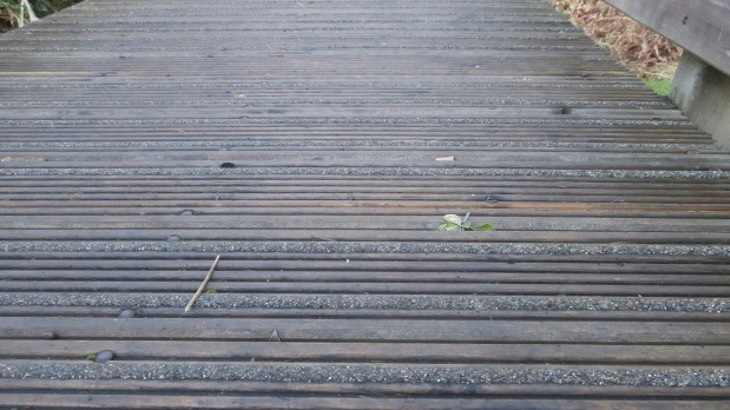
Skid-resistant material within timber decking.
10.5.4
Disused tunnels can form a component of traffic-free routes, particularly through areas of challenging terrain where the provision of suitably graded routes would be impractical. Reopening a disused tunnel can be technically challenging and costly.
However, there are a number of examples of where this has been achieved successfully.
Specialist advice should be sought at the earliest possible stage when considering reopening a tunnel.
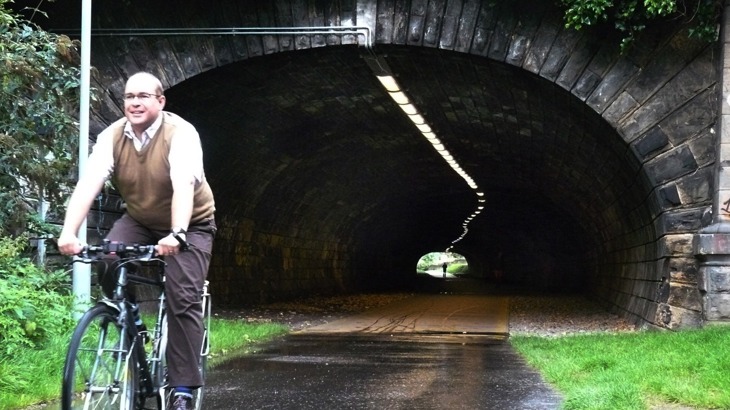
Lit path in Rodney Street Tunnel, Edinburgh.
10.6 Drainage
10.6.1
Drainage for traffic-free routes should be designed in accordance with sustainable drainage principles.
In most cases, this will be achieved simply through the surface water run-off from the path soaking away into the verge. This would need to be confirmed through early ground investigation or soakaway testing.
It may be necessary to construct a stone-filled trench to facilitate the soaking away of run-off.
Attention should be given to the detailing of this approach, as it is undesirable to have a stone-filled trench finished with loose stone immediately adjacent to a path as this may present a hazard to people riding bikes.
It may be necessary to cover the stone with a layer of soil laid on a geotextile.
10.6.2
Drainage features can often be used to create interest in the path, both visually and ecologically.
It may be possible to discharge surface water run-off to a shallow scrape or pond.
When creating such features, consideration needs to be given to whether they might create a hazard for path users and how they are going to be maintained.
10.6.3
Positive drainage systems (gullies and pipes) are rarely required on traffic-free routes.
However, where gullies are provided they should be set flush with the final surface level of the path.
Appropriate cycle-friendly gully gratings need to be provided. If slotted gully gratings are used the slots should be aligned at right angles to the direction of travel.
The provision of gullies will also increase the level of maintenance required for a traffic-free route, as they need to be kept clear of debris to function.
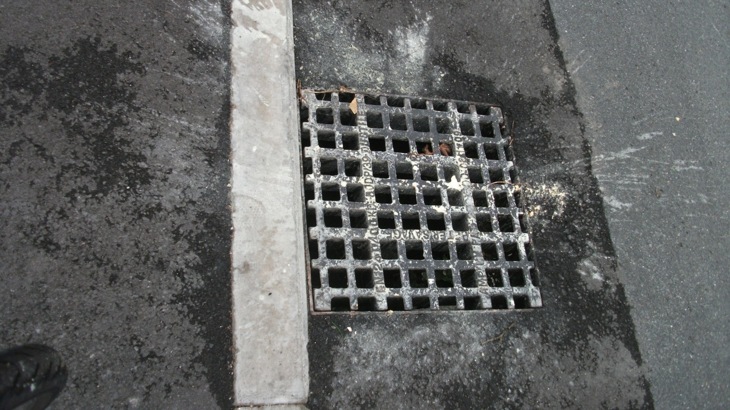
Cycle-friendly gully grate.
10.6.4
Within rural settings, it is typical to install pipes at gradients to achieve a minimum velocity of 1 metre per second (m/s).
This will help to aid self-cleaning and reduce maintenance requirements. Furthermore, the provision of 450mm diameter pipe can also facilitate a reduction in maintenance requirements.
10.6.5
The design of a traffic-free route should take account of the existing drainage regime through the site in which it will be introduced.
Any exiting drainage systems and networks must not be disrupted because of new traffic-free routes.
It is not permissible to allow water from a traffic-free route to discharge onto adjacent property without the landowner’s consent.
Permission or consent will be required from the relevant drainage authority to discharge surface water into an existing drain or watercourse.
10.6.6
Drainage outfalls can often take the form of shallow scrapes, ponds, existing drainage networks and watercourses.
It is imperative that the local drainage authority is contacted to begin discussions about network capacities where new routes are being constructed. Agreed methods of discharge will need to be discussed in advance of design and construction works.
10.7 Flooding
10.7.1
The flooding of a traffic-free route can have significant impacts on the operation and safety of a route. Inundation of the path can serve to:
- Sever a traffic-free route.
- Cause substantial damage to the composition of the path.
- Exclude certain user groups from the path.
- Lead to serious injury where the alignment of the path cannot be determined.
As traffic-free routes often follow existing watercourses, the risk of flooding should be a significant consideration during the design and planning of a traffic-free route.
Designers must adopt a risk-based approach to this assessment and determine how the route could be affected during certain flood events. Where future flood events are likely to cause safety issues, designers may choose to:
- Abandon the route choice and explore an alternative route that avoids the area of flooding.
- Adopt a more robust path construction specification that is less susceptible to water damage.
- Increase the height of a path to avoid or reduce flooding.
- Temporarily close the path and use diversion routes during flood events.
Designers will need to determine when flooding becomes a safety issue for path users on a case-by-case basis.
This will be informed by factors such as the level and type of usage of the route, the nature of any flooding and the frequency at which flooding will occur.
Where designers determine that flooding can be tolerated, alongside an appropriate mitigation measure, they must also ensure that emergency flood plans and warning systems are incorporated into the design.
10.7.2
Where occasional flooding is expected and a risk assessment has deemed that the risks can be mitigated with diversion routes, and then these must be identified and clearly signed.
Diversion routes must be high quality and accessible to all users of the route.
Care should be taken to not just use the nearest and shortest alternative route as a diversion route.
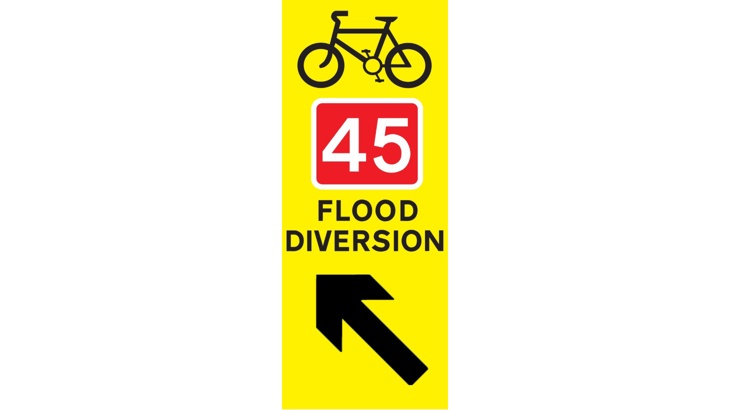
Example Flood Diversion Signing.
10.7.3
Where a path crosses a river or stream floodplain, raising the level of a path, even by a nominal amount, may be sufficient to ensure that the path remains dry for longer, and as flooding recedes can be used again sooner.
However, raising the level of a path above the surrounding ground level may affect the drainage and flood storage capacity of the wider area.
Therefore, proposals to raise the level of a path by even a small amount should be discussed with the appropriate flood control agency.
10.8 Landscaping
10.8.1
Landscaping can be used to minimise the visual impact of a traffic-free route, particularly in rural and natural environments.
Landscaping can also be used in urban environments to increase interest in a route, particularly where users may be used to an otherwise built-up environment that lacks planting and useable public space.
10.8.2
Planting is one means of improving the visual appearance of a traffic-free route. However, this should be undertaken sensitively and in accordance with advice from an ecologist.
It is also important to consider the maintenance requirements of any planting introduced along a traffic-free route and consider low height/slow-growing plants to maintain sightlines.
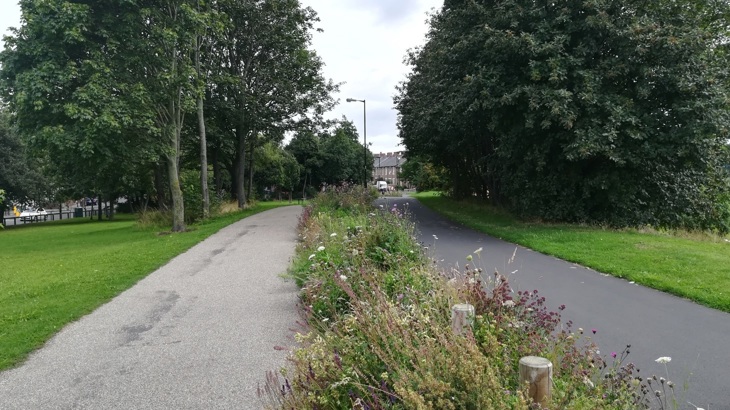
Planted separation strip, Warwick Street Park, Newcastle.
10.8.3
Adjacent landowners may be concerned about the impact of a new route and users of the route being able to see into their property.
Earthworks can be used to create privacy banks, shielding adjacent properties from the users of the route.
The nature of the traffic-free route corridor will determine whether there is space available to achieve this.
10.8.4
Where the route corridor is not wide enough to construct privacy banks, a similar effect can be created by lowering the path where the ground profile permits.
When adopting this approach, it is important to firstly consider drainage, but also to consider retaining long open views along the path.
This can be achieved by ensuring that embankments adjacent to the lowered path consist of grassed slopes as opposed to planting.
10.8.5
The alignment of a path close to a highway may result in users of the path encountering traffic noise and poor air quality, which can serve to detract from the enjoyment of the route.
Introducing vegetation alongside traffic-free routes can be effective in shielding a route from excessive traffic noise and improving air quality.
The additional visual benefits of vegetation can serve to improve the overall quality and experience of the route.
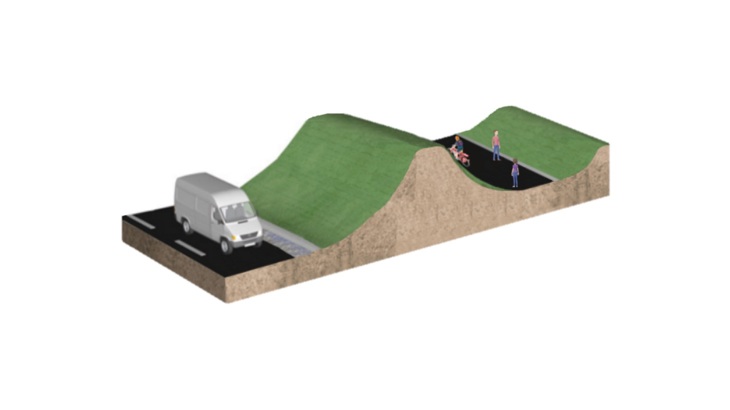
Example embankment to restrict traffic noise.
10.8.6
Whist the preference is usually to provide visual separation from an adjacent road to create a more attractive route, there may be cases where it is desirable to maintain a visual relationship between the traffic-free route and the road.
This is particularly relevant in areas with a prevalence of anti-social behaviour, where good levels of natural surveillance are necessary to support personal security.
10.9 Fencing and hedges
10.9.1
Wherever possible, traffic-free routes should be unfenced. This will provide a more open visual aspect, lessen concerns about personal security of path users, and reduce construction and maintenance costs. However, fencing may be required along one or both sides of a route to ensure:
- Safety of path users
- Security of neighbours
- Livestock control.
10.9.2
Fencing or building lines positioned directly along a path edge reduce the effective width of a path and creates an enclosed environment.
Wherever possible, fence lines (over 600mm high) should be set back at least 0.5m from the path edge to minimise the tunnel-like appearance of a path.
10.9.3
Fencing should be as visually unobtrusive as possible. In most cases, 1.2m high fencing is adequate for user safety and livestock control.
Most route users will be able to see over fencing at this height and the negative aesthetic impact and sense of enclosure will be minimised.
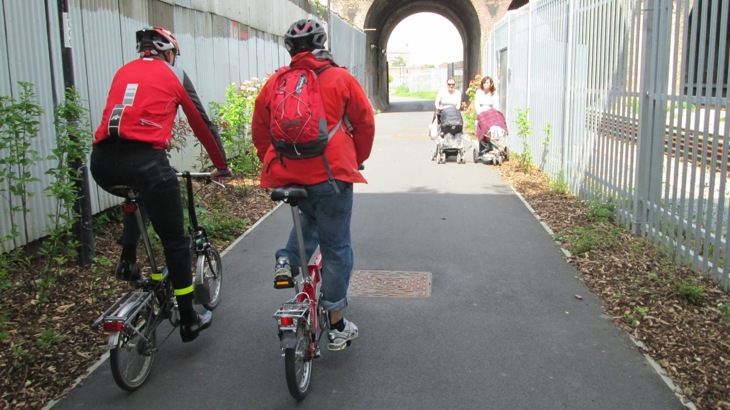
Security fencing and hoarding can serve to create a route that feels enclosed, Bermondsey, London.
10.9.4
Where adjacent landowners require their land to be enclosed, the type of fence should be agreed with them.
Timber post and rail stock-proof fencing are often preferred.
However, timber post and wire fencing with stock-proof mesh may be sufficient for safety or livestock control.
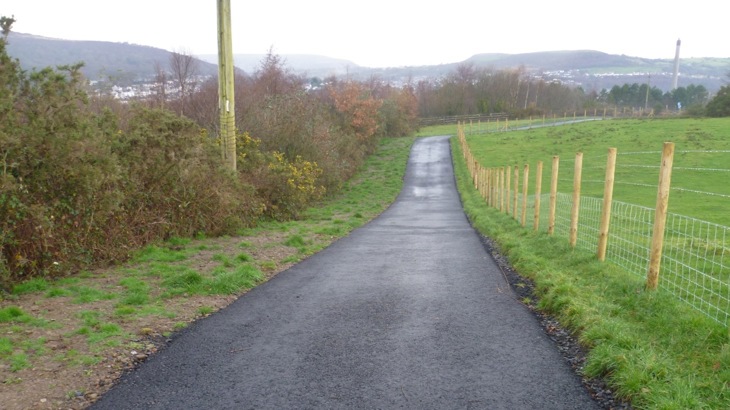
Timber post and wire mesh fencing creates a route that feels open, Glais, Wales.
10.9.5
Security fencing can be unattractive and oppressive, and traffic-free routes through urban areas can quickly become enclosed for considerable distances.
Where adjoining premises require security, weldmesh fencing is a good alternative to palisade fencing. It is largely unclimbable but less visually oppressive.
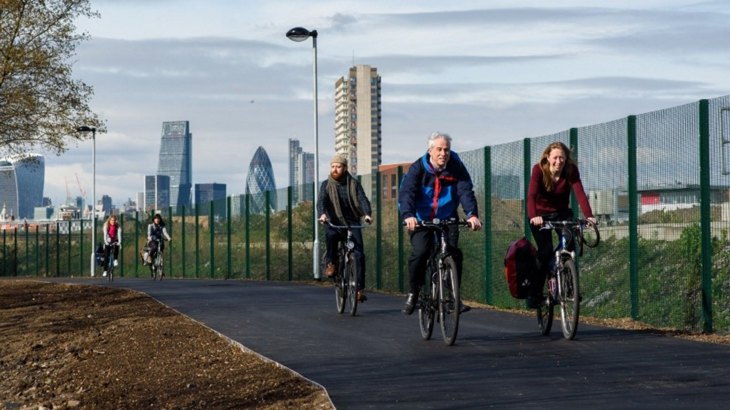
Weldmesh fencing on the Millwall Path, London.
10.9.6
Traffic-free routes adjacent to railways always require fencing. To maintain the required clearance to the railway line, the fence may need to be closer to the path than is desirable.
In urban areas, palisade fencing is used to prevent access to the railway, although less visually oppressive examples, including weldmesh-type fencing or lower fencing, have successfully been used on routes.
In rural areas, less intrusive fencing such as timber post and wire fencing can provide an aesthetically pleasing environment whilst preventing unwanted access into the rail corridor.
Where routes are located in close proximity to a rail corridor, it is critical that Network Rail is engaged as a key stakeholder at an early design stage.
Through this process, discussions and negotiations can be held to find the most appropriate fencing solutions to address the needs of all stakeholders.
10.9.7
Hedgerows can provide an attractive bounding feature for rural and semi-rural traffic-free routes and can offer protection from wind.
Hedgerows should be set back sufficiently far from the edge of the path to allow for growth of the hedge.
Thorny species such as hawthorn, dog rose or gorse should be avoided due to the increased risk of punctures for people riding bikes.
As with any planting, advice should be sought from an ecologist and future maintenance requirements should be considered, as hedging, in particular, can grow into the path if not tended to, which can result in a reduction in effective width.
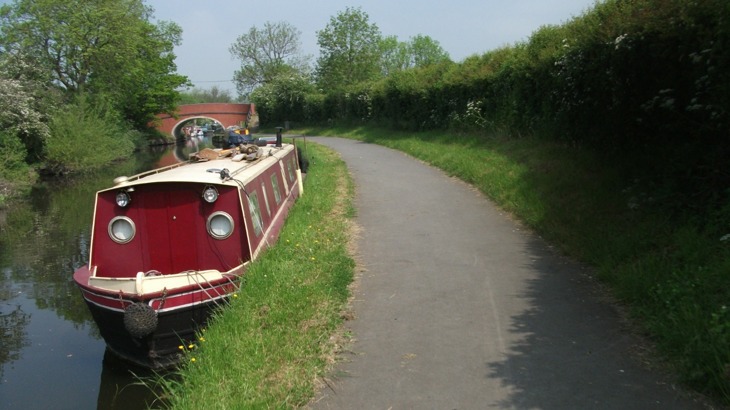
Hedge set back from path edge, Grand Union, Leicester.
10.9.8
Where there is a hazard adjacent to a traffic-free route, such as a steep drop or a water feature, the need to provide fencing as edge protection should be considered by the designer, following a risk-based approach.
This assessment should consider factors such as the nature of the hazard, the likelihood of a user leaving the path, whether the fencing presents a different hazard, and what the impact of vandalism might be on the fence.
10.9.9
Where there is a water hazard adjacent to a traffic-free route, the need for fencing will be determined by:
- the velocity of the water
- depth of the watercourse
- the nature of the ground between the path and the water
- the height differential
- the gradient, width and horizontal alignment of the path
- and the nature of the use of the path.
It should be noted that many traffic-free routes have operated alongside water features with no need for fencing. Canal towpaths are rarely fenced off except at discrete locations.
10.10 Artwork and other features
10.10.1
The attractiveness of traffic-free routes can be improved by incorporating interpretive features and artwork.
These features can help create a strong sense of location, creating attractive places that people want to use for walking and cycling.
10.10.2
Interpretation boards can provide users with information about the route or features in the area. This might include local history, ecology to look out for, or other points of interest.
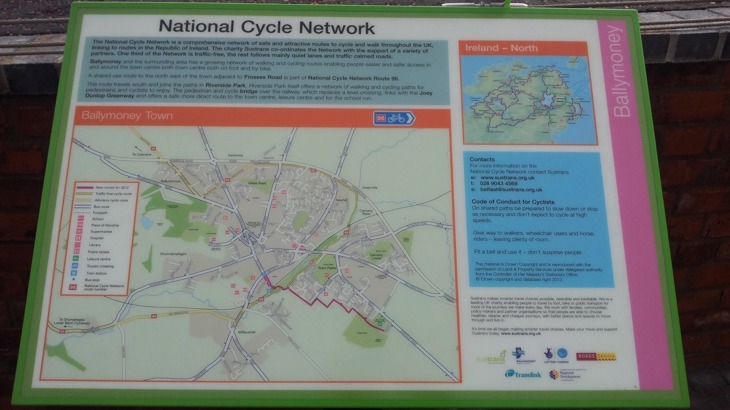
Information board from NCN Route 96, Ballymoney, Northern Ireland.
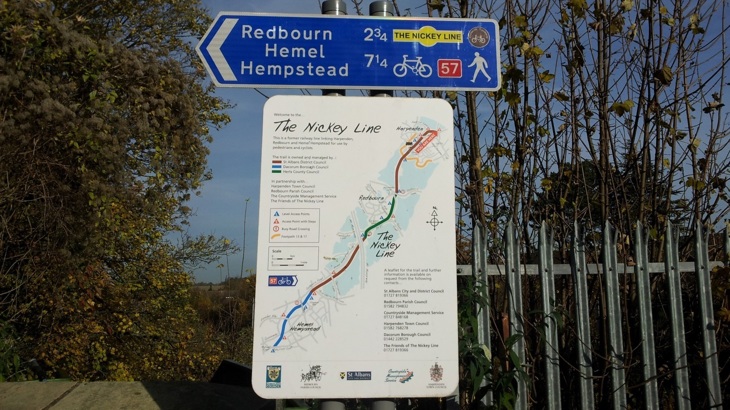
Information board on The Nickey Line, Hertfordshire.
10.10.3
Art is an important element of placemaking. It can introduce intrigue and make a route worth using just for the opportunity of seeing and experiencing a piece of art.
The most successful public art allows people to interact with it, see through it, sit next to it, use it, and play with it.
Opportunities to develop exciting artworks should be considered as part of the planning of a traffic-free route and could form part of the engagement with the local community.
10.10.4
Seating provides an extra element of comfort to a route and encourages the community to make the place their own, which is fundamental to help users feel safe. Seating can maximise local activity, allowing people to socialise and to linger.
In some locations, they can be associated with tables or play equipment.
Providing seating can offer an opportunity to make the most of a beautiful view or sunny spot. Consideration should be given to providing seating at regular intervals.
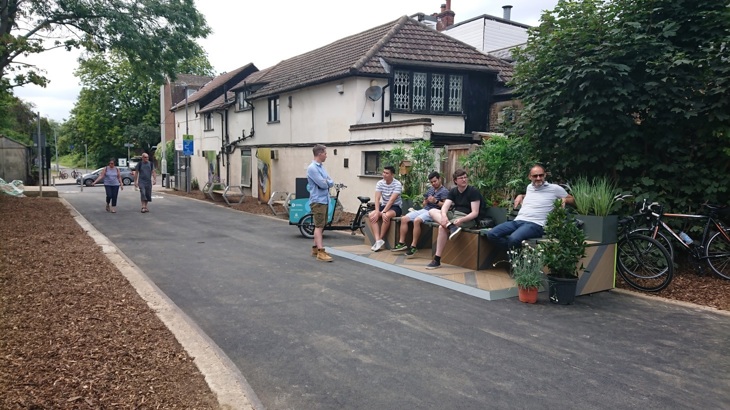
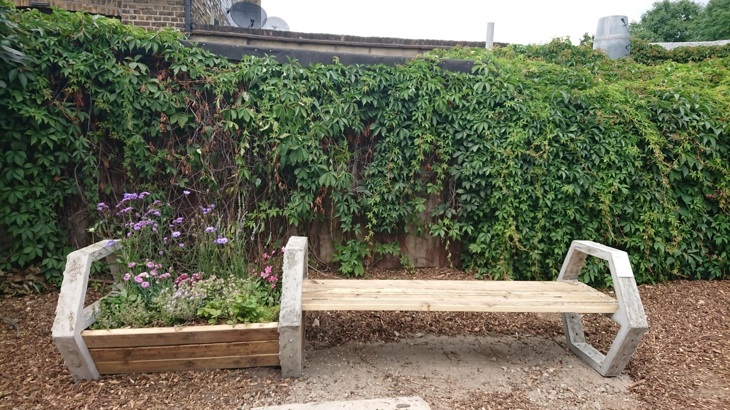
Seating introduced along New Malden Raynes Park Scheme, London.
10.10.5
It is essential to consider the provision of cycle parking where a traffic-free route provides access to a destination.
The design of any cycling parking must consider the space requirements of larger adaptive or utility type bikes, as well as the space requirements of the users of these types of bikes.
Parking provision for adaptive bikes must have step-free access.
There are increasingly creative ways of providing accessible, attractive, convenient and secure parking, which needs to be considered as part of the planning and design of a traffic-free route.
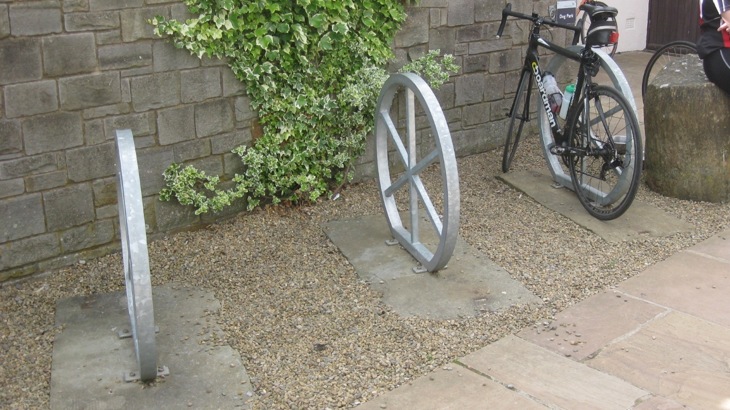
Cycle parking at Hadrian’s Wall Visitor’s Centre.
10.10.6
Traffic-free routes can provide opportunities for local businesses to develop, particularly where there is a high degree of leisure or tourism use on a traffic-free route.
This might include cafés, bike hire and bike repair businesses and even accommodation provision.
10.10.7
Where possible, bike service points can be integrated into a route to allow users to pump tyres or repair a puncture and cause minimal interruption to a journey.

